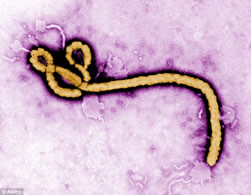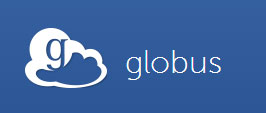HiPACC Data Science Press Room. From: SDSC
The Data Science Press Room highlights computational and data science news in all fields *outside of astronomy* in the UC campuses and DOE laboratories comprising the UC-HiPACC consortium. The wording of the short summaries on this page is based on wording in the individual releases or on the summaries on the press release page of the original source. Images are also from the original sources except as stated. Press releases below appear in reverse chronological order (most recent first).
October 29, 2014 — SDSC’s Chaitan Baru named CISE Data Science Advisor at NSF
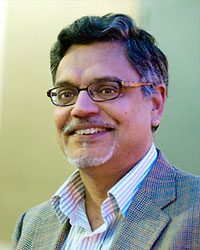
Chaitan Baru. Credit: Alan Decker
SDSC 10/29/2014—The National Science Foundation (NSF) has named Chaitan Baru, a Distinguished Scientist at the San Diego Supercomputer Center (SDSC) at UC San Diego, Senior Advisor for Data Science in the agency’s Computer and Information Science and Engineering Directorate (CISE). Baru was Associate Director for Data Initiatives at SDSC, and is now on assignment in his new position with the NSF in the greater Washington DC area. He will serve as advisor to the CISE Directorate, assisting in cross-directorate and interagency efforts pertaining to what has become known as ‘Big Data’, or what the NSF describes as “large, diverse, complex, longitudinal, and/or distributed datasets generated from instruments, sensors, Internet transactions, email, video, click streams, and/or all other digital sources available today and in the future.” CISE, one of seven NSF directorates, supports investigator-initiated research in all areas of computer and information science and engineering and fosters broad interdisciplinary collaboration.
View SDSC Data Science Press Release
October 6, 2014 — RCSB Protein Data Bank launches mobile application

Credit: RCSB Protein Data Bank
SDSC 10/6/2014—The RCSB Protein Data Bank (PDB), which recently archived its 100,000th molecule structure, has introduced a free mobile application device that enables the general public and expert researchers to quickly search and visualize the 3D shapes of proteins, nucleic acids, and molecular machines. “As the mobile web is starting to surpass desktop and laptop usage, scientists and educators are beginning to integrate mobile devices into their research and teaching,” said Peter Rose, a researcher with the San Diego Supercomputer Center (SDSC) at UC San Diego, and Scientific Lead with the RCSB PDB. “In response, we have developed this application for iOS and Android mobile platforms to enable fast and convenient access to RCSB PDB data and services.” The goal was to produce an intuitive app with a simple search interface, quick browsing of search results, a view of basic data about a structure entry and its Pub-Med abstract, and high-performance molecular visualization. In addition, the app provides access to the RCSB PDB
Molecule of the Month educational series, and can be used to store personal notes and annotations.
View SDSC Data Science Press Release
October 1, 2014 — SDSC granted $1.3 million award for ‘SeedMe.org’ data sharing infrastructure
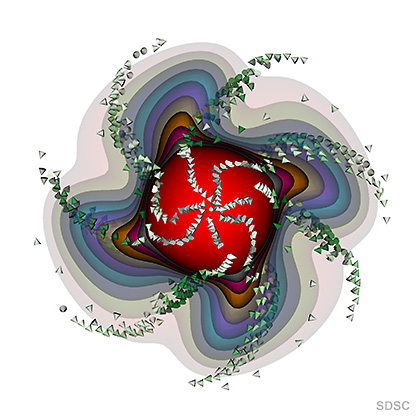
This image and related research data, one of numerous projects being shared and stored using SeedMe, shows a simple model of a geodynamo used for benchmark codes. The view is from center toward one of the poles, and the cones show convective flow toward higher temperature (light green to dark green with increasing velocity) in a spiraling form caused by rotation. The shells of various colors depict temperature, increasing from the outer boundary towards the interior. Credit: Amit Chourasia, Ashley Willis, Maggie Avery, Chris Davies, Catherine Constable, David Gubbins
SDSC 10/1/2014—Researchers at the San Diego Supercomputer Center (SDSC) at UC San Diego have received a three-year, $1.3 million award from the National Science Foundation (NSF) to develop a web-based resource that lets scientists seamlessly share and access preliminary results and transient data from research on a variety of platforms, including mobile devices. Called Swiftly Encode, Explore and Disseminate My Experiments (SeedMe), the new award is from NSF’s Data Infrastructure Building Blocks (DIBBs) program, part of the foundation’s Cyberinfrastructure Framework for 21st Century Science and Engineering (CIF21). Current methods for sharing and assessing transient data and preliminary results are cumbersome, labor intensive, and largely unsupported by useful tools and procedures. “SeedMe provides an essential yet missing component in current high-performance computing as well as cloud computing infrastructures,” said SDSC Director Michael Norman, co-principal investigator on the project.
View SDSC Data Science Press Release
September 9, 2014 — The search for Ebola immune response targets
SDSC 9/9/2014—The effort to develop therapeutics and a vaccine against the deadly Ebola virus disease (EVD) requires a complex understanding of the microorganism and its relationship within the host, especially the immune response. Adding to the challenge, EVD can be caused by any one of five known species within the genus Ebolavirus (EBOV), in the Filovirus family. Now, researchers at the La Jolla Institute for Allergy and Immunology (La Jolla Institute) and the San Diego Supercomputer Center (SDSC) at UC San Diego are assisting the scientific community by running high-speed online publications of analysis of data in the Immune Epitope Data Base (IEDB), and predicting epitopes using the IEDB Analysis Resource.
View SDSC Data Science Press Release
September 9, 2014 — SDSC joins the Intel Parallel Computing Centers Program
SDSC 9/9/2014—The San Diego Supercomputer Center (SDSC) at UC San Diego is working with semiconductor chipmaker Intel Corporation to further optimize research software to improve the parallelism, efficiency, and scalability of widely used molecular and neurological simulation technologies. The collaboration is part of the Intel Parallel Computing Centers program, which provides funding to universities, institutions, and research labs to modernize key community codes used across a wide range of disciplines to run on current industry-standard parallel architectures. SDSC researchers are expanding the Intel relationship to cover additional research areas and software packages, including improving the performance of simulations on manycore architectures, to allow researchers to study chemical reactions directly, without severe approximations. With President Obama’s announcement of the BRAIN initiative in April 2013, many are predicting computational neuroscience will have a scientific impact to rival what computational genomics had during the last decade.
View SDSC Data Science Press Release
August 27, 2014 — National Biomedical Computation Resource receives $9 million NIH award
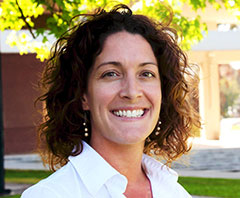
National Biomedical Computation Resource director Rommie Amaro
SDSC 8/27/2014— The National Biomedical Computation Resource (NBCR) at UC San Diego has received $9 million in funding over five years from the National Institutes of Health (NIH) to allow NBCR to continue its work connecting biomedical scientists with supercomputing power and emerging information technologies. NBCR Director Rommie Amaro said that the renewed funding will make it possible for biomedical researchers to study phenomena from the molecular level to the level of the whole organ. Biomedical computation—which applies physical modeling and computer science to the field of biomedical sciences—is often a cheaper alternative to traditional experimental approaches and can speed the rate at which discoveries are made for host of human diseases and biological processes.
View SDSC Data Science Press Release
August 21, 2014 — SDSC mourns the loss of J. Freeman Gilbert
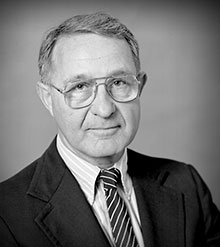
J. Freeman Gilbert. Credit: Scripps Institution of Oceanography Archives, UC San Diego Library
SDSC 8/21/2014— In addition to being a Distinguished Professor of geophysics with the Scripps Institution of Oceanography (SIO) for more than 53 years, James Freeman Gilbert is being remembered by those at the San Diego Supercomputer Center (SDSC) for playing an integral role in securing a National Science Foundation (NSF) award to establish SDSC on the UC San Diego campus almost 30 years ago. A leading contributor in computational geophysics, seismology, earthquake sources, and geophysical inverse theory, Gilbert was the author of numerous research papers, book chapters, reviews, and other publications. He passed away on August 15, 2014 in Portland, Oregon, due to complications from a car accident. He was 83.
View SDSC Data Science Press Release
July 30, 2014 — UC San Diego’s WIFIRE project helps firefighters get a jump on wildfires

New cyberinfrastructure system monitors and forecasts wildfire activity. Credit: WIFIRE/UC San Diego
SDSC 7/30/2014—With a multi-year, $2.65 million grant from the National Science Foundation (NSF), UC San Diego and the University of Maryland have been building a cyberinfrastructure to better monitor, predict, and mitigate wildfires in the future. The project, called WIFIRE and started in late 2013, is already cataloging and integrating data related to dynamic wildfire models from a variety of resources including sensors, satellites, and scientific models, and creating visual programming interfaces for using that data in scalable wildfire models. The project will hold its first workshop for dynamic-data driven wildfire modeling in January 2015. The system will integrate networked observations such as heterogeneous satellite data and real-time remote sensor data, with computational techniques in signal processing, visualization, modeling, and data assimilation to provide a scalable method to monitor such phenomena similar to weather patterns that can help predict a wildfire’s rate of spread.
View SDSC Data Science Press Release
July 7, 2014 — SDSC’s new ‘SeedMe’ resource invites researchers to rapidly share results
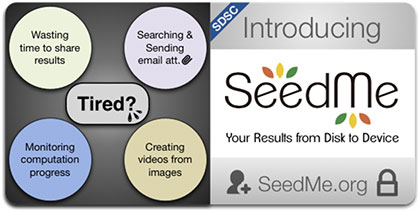
SDSC 7/7/2014— A team of SDSC researchers has developed a working implementation of SeedMe, short for ‘Swiftly Encode, Explore, Disseminate My Experiments.’ While SeedMe could be described in general terms as a DropBox for science, the computational research community requires several additional capabilities and integration tools. The team developed a web-based architecture that not only supports videos and other visualizations, but content such as plots, files, and tickers—all of which are essential to scientific research. The goal is to offer a means for scientists to seamlessly share and stream data-intensive visualizations on a variety of platforms, including mobile devices, to enable rapid sharing of content directly from applications running on HPC- or cloud-based resources. SeedMe is unique from other web-based interfaces in that it is completely focused on efficiently sharing scientific content.
View SDSC Data Science Press Release
July 7, 2014 — SDSC’s kc claffy receives annual IEEE Internet Award

kc claffy. Credit: Ben Tolo, SDSC
SDSC 7/7/2014—kc claffy, the principal investigator and co-founder of the Center for Applied Internet Data Analysis (CAIDA) based at the San Diego Supercomputer Center (SDSC) at UC San Diego, has been awarded the latest IEEE (Institute of Electrical and Electronics Engineers) Internet Award. claffy was recognized by the IEEE for her “seminal contributions to the field of Internet measurement, including security and network data analysis, and for distinguished leadership in and service to the Internet community by providing open-access data and tools.”
View SDSC Data Science Press Release
July 2, 2014 — SDSC assists researchers in novel wildlife tracking project
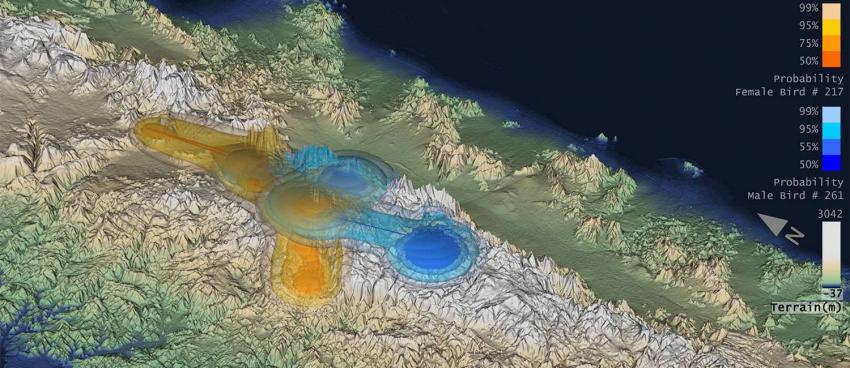
An image from a sequence of visualizations from analysis to identify home range in 3D of California condors. The blue and orange colored surfaces show probabilities of male and female birds, respectively. Credit: San Diego Supercomputer Center, San Diego Zoo, and U.S. Geological Survey
SDSC 7/2/2014—A team including researchers from the U.S. Geological Survey (USGS) and the San Diego Zoo’s Institute for Conservation Research has developed a novel methodology to monitor endangered wildlife. It is the first to combine 3D and advanced range estimator technologies to provide highly detailed data on the range and movements of terrestrial, aquatic, and avian wildlife species. Relying high-performance programming and computerized visualization expertise from researchers at the San Diego Supercomputer Center (SDSC) at UC San Diego, the team created highly detailed data sets and visualizations after they tracked three highly iconic but threatened species: California condors, giant pandas, and dugongs (a large marine animal somewhat similar to the manatee). Since 3D modeling is much more computationally data intensive than 2D, what started as a supercomputing challenge evolved into an exercise in optimizing codes to allow current problems of interest to be done on laptops or even smart phones. Gordon is being used to create interactive visualizations, and will make it easier for the software developers to explore the impact of algorithmic modifications on the quality of the solution.
View SDSC Data Science Press Release
June 25, 2014 — UC San Diego to launch new master’s program in data science and engineering
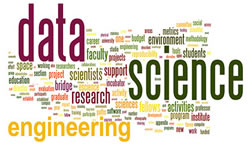
Computer science and engineering SDSC program to start in fall 2014
SDSC 6/25/14—UC San Diego has announced a new master’s degree program in Data Science and Engineering, intended for working professionals with a broad educational background and/or training in computer science, engineering, or mathematics. The Data Science and Engineering master’s degree program is taught by world-renowned professors and researchers from the Department of Computer Science and Engineering (CSE) in the UC San Diego Jacobs School of Engineering, in collaboration with the university’s San Diego Supercomputer Center (SDSC). The two-year, part-time program is completed in person on the UC San Diego campus and leads to a Master of Advanced Study (MAS) degree. “The data scientist is a new kind of professional, one who combines the skills of a software programmer, database manager, statistician, and communicator capable of creating mathematics-based models of data, identifying trends and deviations, and presenting them in compelling, visual ways,” said Rajesh Gupta, professor and chair in the Department of Computer Science and Engineering. “The very nature and process of scientific research is changing in the era of ‘big data’, and this innovative master’s program is our response to the growing demand for data scientists able to meet this new challenge.”
View SDSC Data Science Press Release
May 14, 2014 — Protein Data Bank archives its 100,000th molecule structure
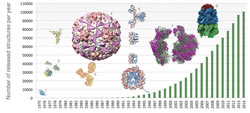
The number of structures available in the Protein Data Bank per year, as of May 14, 2014. Credit: wwPDB
SDSC 5/14/14—The Protein Data Bank (PDB) is the single worldwide repository for the three-dimensional structures of large molecules and nucleic acids that are vital to pharmacology and bioinformatics research. Recently, PDB archived its 100,000th molecule structure, doubling its size in just six years. Four data centers, including the San Diego Supercomputer Center (SDSC)/Skaggs School of Pharmacy and Pharmaceutical Sciences at UC San Diego, support online access to the three-dimensional structures of biological macromolecules. Those structures help researchers understand many facets of biomedicine, agriculture, and ecology, from protein synthesis to health and disease to biological energy.
View SDSC Data Science Press Release
April 14, 2014 — The mechanism of short-term memory
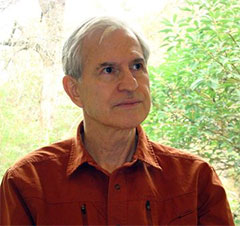
Lester Ingber, UC San Diego Ph.D. '66
SDSC 4/14/14 — Using the Trestles supercomputer at the San Diego Supercomputer Center, researchers found for the first time that in-sync large-scale brain waves affecting various regions of the brain hold memories of objects just viewed. This study provides more evidence that large-scale electrical oscillations across distant brain regions may carry information for visual memories. For Lester Ingber, a researcher based in Ashford, Oregon who received a Ph.D. in physics from UC San Diego in 1966, those types of studies by other established researchers that have begun to emerge only in recent years highlight a concept he’s been investigating for more than 30 years: the relationship between large-scale, or “top-down” activities in the brain and short-term memory and consciousness.
View SDSC Data Science Press Release
April 7, 2014 — SDSC enables large-scale data sharing using Globus
SDSC 4/7/14 — In the era of Big Data-enabled science, accessing and sharing of huge data sets plays a key role for scientific collaboration and research. Some San Diego Supercomputer Center (SDSC) users need to share large data sets with collaborators who may not have accounts on SDSC resources. Described as a “dropbox for science,” Globus is already widely used by resource providers and users who need a secure and reliable way to transfer files. SDSC is the first supercomputer center in the National Science Foundation’s XSEDE (eXtreme Science and Engineering Discovery Environment) program to offer the new and unique Globus sharing service.
View SDSC Data Science Press Release
April 3, 2014 — SDSC establishes data science workflows ‘center of excellence’
SDSC 4/3/14 — The San Diego Supercomputer Center (SDSC) at UC San Diego, has formally established a new ‘center of excellence’ to assist researchers in creating workflows to better manage the tremendous amount of data being generated across a wide range of scientific disciplines, from natural sciences to marketing research. A data science workflow is the process of combining data and processes into a configurable, structured set of steps that lead to automated computational solutions of an application. Called the WorDS Center (or Workflows for Data Science Center of Excellence), its purpose is to allow scientists to focus on their specific areas of research rather than having to solve workflow issues, or the computational challenges that arise as data analysis progresses from task to task.
View SDSC Data Science Press Release
March 26, 2014 — Challenges, opportunities of Big Data Big Data’s exponential rise brings changes, challenges, and opportunities

Faculty and industry leaders discussed the latest research, services, and education development in big data. (l to r) Michael Zeller, founder/CEO of San Diego-based Zementis; SDSC Director Michael Norman, SDSC’s PACE Director Natasha Balac, Larry Smarr, founding director CalIT2; and Stefan Savage, professor, Computer Science & Engineering, UC San Diego. (Image: Erik Jepsen, UC San Diego Publications)
SDSC 3/26/14 — Big data — defined as the gathering, storage, and analysis of massive amount of computerized data — is big business: a market growing at 45 percent annually that will reach $25 billion by 2015. Harnessing big data — and having the ability to extract meaningful information from it to advance scientific discovery — was a key topic during a recent symposium called “Big Data at Work: A Conversation with the Experts,” held at Atkinson Hall at UC San Diego’s Qualcomm Institute. “What’s different about big data in science now is the challenge of taking trillion of bytes of data that come from somewhere else, reading them into a supercomputer, and doing something with that data that contributes to new science and new knowledge,” said SDSC director Michael Norman.
View SDSC Data Science Press Release
March 19, 2014 — SDSC’s Gordon supercomputer assists in whole-genome sequencing analysis
SDSC 3/19/14 — A recent whole-genome sequencing (WGS) analysis project, supported by the San Diego Supercomputer Center (SDSC) at UC San Diego, assisted in a major study of rheumatoid arthritis. The collaborative project, which also involved Janssen Research and Development, LLC and the Scripps Translational Science Institute, demonstrated the effectiveness of innovative applications of flash memory technology to rapidly process large data sets that are pervasive throughout human genomics research.
View SDSC Data Science Press Release



